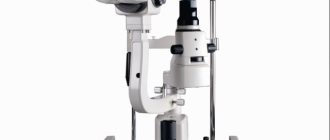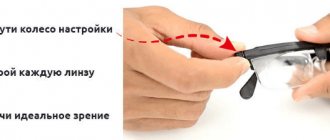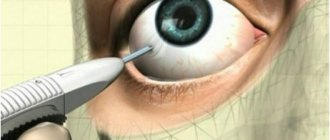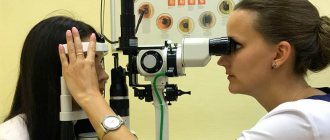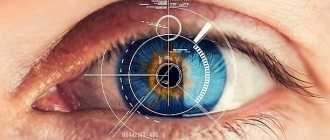Visual analyzer
Represented by the perceptive department - receptors of the retina, optic nerves, conduction system and corresponding areas of the cortex in the occipital lobes of the brain.
Includes the cornea, lens, vitreous body, fluid of the anterior and posterior chambers of the eye.
The cornea is composed of collagen fibrils that have a parallel orientation. Microscopically, 5 layers are distinguished: 1. Anterior stratified squamous non-keratinizing epithelium 2. Anterior limiting membrane (Bowman's membrane) 3. Corneal substance 4. 3 posterior limiting membrane (Descemet's membrane) 5. Posterior epithelium. The anterior epithelium is multilayered squamous, non-keratinizing, covered with lacrimal fluid, and contains many receptor endings. The posterior epithelium is single-layer squamous.
Lens. It is based on lens fibers (each fiber is a transparent hexagonal prism), which are derivatives of epithelial cells without nuclei. The cytoplasm of the lens fibers contains a transparent protein, crystallin. The central fibers shorten and overlap each other to form the nucleus of the lens. The outside of the lens is covered with a transparent capsule (similar to a thickened basement membrane). Cambial cells are located on the posterior surface of the lens. The lens is fixed using the fibers of the ciliary girdle, which are attached to the ciliary body on one side and to the lens capsule on the other.
The vitreous body is a transparent jelly-like mass. Fills the cavity between the lens and retina. Contains protein vitrein and hyaluronic acid.
Aqueous humor fills the anterior and posterior chambers of the eye. The composition of moisture is close to blood plasma, but it is separated from the blood by a barrier that prevents the penetration of leukocytes into it.
The mechanism of photoreception is associated with the breakdown of rhodopsin and iodopsin molecules under the influence of light energy. This triggers a chain of biochemical reactions, which are accompanied by a change in membrane permeability in rods and cones and the appearance of an action potential. After the breakdown of the visual pigment, its resynthesis follows, which occurs in the dark and in the presence of vitamin A. A lack of vitamin A in food can lead to impaired twilight vision (night blindness). Color blindness (color blindness) is explained by the genetically determined absence of one or more types of cones in the retina. The excitation of the neurosensory cell is transmitted through the central process to the 2nd bipolar neuron. The cell bodies of bipolar neurons lie in the inner nuclear layer of the retina. In this layer, in addition to bipolar neurons, there are two more types of associative neurons: horizontal and amacrine. Bipolar neurons connect rod and cone optic cells to neurons in the ganglion layer. In this case, cone cells contact bipolar neurons in a 1:1 ratio, while several rod cells form connections with one bipolar cell. Horizontal nerve cells have many dendrites, with the help of which they contact the central processes of photoreceptor cells. The horizontal cell axon also makes contact with synaptic structures between the receptor and bipolar cells. Multiple synapses of a peculiar type arise here. The transmission of impulses through such a synapse and further with the help of horizontal cells can cause the effect of lateral inhibition, which increases the contrast of the image of the object. A similar role is played by amacrine neurons located at the level of the inner reticular layer. Amacrine neurons do not have an axon, but have branched dendrites. The neuron body plays the role of a synaptic surface.
Refractive errors: myopia, farsightedness, astigmatism. Causes of disturbances in light perception. Visual acuity. Binocular vision. Spatial vision. Adaptation of the visual analyzer.
Myopia or myopia is the most common type of refractive error. With myopia, objects can be seen more or less clearly only at a close distance, which is why the very concept of “myopia” arose. With myopia, the image of objects in the eye is formed in front of the retina. At the same time, in people suffering from myopia (myopia), the length of the eye is increased (axial myopia), or the cornea has a greater refractive power, which causes a change in the focal length (refractive myopia). Usually these two points are combined. Myopia (or myopia) appears due to excessive growth of the eyeball and the strong refractive power of the optical apparatus, which is manifested by decreased distance vision.
At the moment, there is no single substantiated scientific concept of the development of myopia. It is assumed that different types of myopia have different origins, and their development is due to one of the factors or has a complex genesis.
Various factors can contribute to the occurrence and development of myopia (myopia):
- severe visual stress, poor lighting of the workplace, as well as incorrect sitting position when reading and writing, reading while lying down;
- hereditary predisposition;
- congenital weakness of connective tissue;
- poor nutrition, various diseases, overwork - i.e. general weakening of the body;
- primary weakness of accommodation, leading to compensatory stretching of the eyeball;
- unbalanced tension of accommodation and convergence, causing a spasm of accommodation and the development of false and then true myopia.
Farsightedness is a visual impairment in which a person sees poorly up close and quite well at a distance. However, with a high degree of farsightedness, the patient may have difficulty seeing distant objects.
Farsightedness usually occurs due to the fact that the eyeball has an irregular shape, as if it is compressed along the longitudinal axis. As a result, the image of the object is focused not on the retina, but behind it. Often the irregular, compressed shape of the eyeball is combined with insufficient optical power of the cornea and lens. Much less often, farsightedness is caused only by the weakness of the optical system of the eye with a normal length of the eyeball.
Symptoms of farsightedness
As mentioned above, the main sign of farsightedness is poor near vision with satisfactory or even excellent distance vision. However, with a high degree of farsightedness, the patient may have difficulty seeing distant objects. In addition, the constant companions of farsightedness are increased eye fatigue, eye strain when reading and writing, headaches, and burning eyes. Farsightedness is often accompanied by inflammatory eye diseases (blepharitis, barley, conjunctivitis), and in children - strabismus and lazy eye syndrome (amblyopia).
Astigmatism is characterized by the fact that the cornea has an irregular shape, as a result of which the refractive power of the cornea is not the same in different meridians. This causes light rays entering the eye to be focused at two points instead of one. Astigmatism often accompanies myopia (myopic astigmatism) or farsightedness (far-sighted astigmatism) or a combination of both (mixed astigmatism).
Typically, astigmatism results in a person's vision being "blurry." Frequent companions of astigmatism are headaches and increased eye fatigue. Note that with low-grade astigmatism, patients may not experience any discomfort, therefore, for timely diagnosis of this, and many other eye diseases, it is necessary to undergo regular preventive examinations by an ophthalmologist.
Binocular vision
- the ability to simultaneously clearly see the image of an object with both eyes;
in this case, a person sees one image of the object he is looking at, that is, this is vision with two eyes, with a subconscious connection in the visual analyzer (cerebral cortex) of the images received by each eye into a single image. Creates three-dimensionality of the image. Binocular vision is also called stereoscopic
.
If binocular vision does not develop, it is possible to see only in the right or left eye. This type of vision is called monocular.
Alternating vision is possible: now with the right, now with the left eye - monocular alternating. Sometimes vision occurs with two eyes, but without merging into one visual image - simultaneous.
The absence of binocular vision with two eyes open externally manifests itself in the form of gradually developing strabismus.
Determination of visual acuity
- a numerical expression of the eye’s ability to perceive separately two points located at a certain distance from each other.
Eye adaptation
- adaptation of the eye to changing lighting conditions. The changes in the sensitivity of the human eye during the transition from bright light to complete darkness (the so-called dark adaptation) and during the transition from darkness to light (light adaptation) have been most fully studied. If an eye that was previously exposed to bright light is placed in the dark, its sensitivity increases at first quickly, and then more slowly.
The eye is a complex optical system of lenses that form an inverted and reduced image of the outside world on the retina.
The diopter consists of a transparent cornea, anterior and posterior chambers filled with aqueous wave, the iris surrounding the pupil, the lens and the vitreous body.
The refractive power of the eye depends on the radius of curvature of the cornea, the anterior and posterior surfaces of the lens, the refractive indices of air, the cornea, aqueous humor, the lens, and the vitreous body.
Perception of images of objects
| This section is missing references to information sources. Information must be verifiable, otherwise it may be questioned and deleted. You may edit this article to include links to authoritative sources. This mark was set on April 3, 2013 . |
A clear image of objects on the retina is provided by the complex unique optical system of the eye, consisting of the cornea, fluids of the anterior and posterior chambers, lens and vitreous body. Light rays pass through the listed media of the optical system of the eye and are refracted in them according to the laws of optics. The lens is of primary importance for the refraction of light in the eye.
For a clear perception of objects, it is necessary that their image is always focused in the center of the retina. Functionally, the eye is adapted for viewing distant objects. However, people can clearly distinguish objects located at different distances from the eye, thanks to the ability of the lens to change its curvature, and, accordingly, the refractive power of the eye. The ability of the eye to adapt to clearly seeing objects located at different distances is called accommodation. Violation of the accommodative ability of the lens leads to impaired visual acuity and the occurrence of myopia or farsightedness.
One of the reasons for the development of myopia is overstrain of the ciliary muscles of the lens when working with very small objects, reading for a long time in poor lighting, or reading in transport. When reading, writing or other work, the object should be placed at a distance of 30-35 cm from the eye. Too bright lighting greatly irritates the photoreceptors of the retina. It also harms your eyesight. The light should be soft and not blind the eyes.
When writing, drawing, drawing with the right hand, the light source is placed on the left so that the shadow from the hand does not darken the work area. It is important to have overhead lighting. If you have prolonged eye strain, you should take 10-minute breaks every hour. You should protect your eyes from injury, dust, and infection.
Visual impairment associated with uneven refraction of light by the cornea or lens is called astigmatism. With astigmatism, visual acuity usually decreases, the image becomes unclear and distorted. Astigmatism is eliminated using glasses with special (cylindrical) lenses.
Myopia is a deviation from the normal ability of the optical system of the eye to refract rays, which consists in the fact that the image of objects located far from the eyes appears in front of the retina. Myopia can be congenital or acquired. With natural myopia, the eyeball has an elongated shape, so rays from objects are focused in front of the retina. Objects located at a close distance are clearly visible, but the image of distant objects is fuzzy and blurry. Acquired myopia develops when the curvature of the lens increases due to metabolic disorders or non-compliance with visual hygiene rules. There is a hereditary predisposition to the development of myopia. The main causes of acquired myopia are increased visual load, poor lighting, lack of vitamins in food, and physical inactivity. To correct myopia, glasses with biconcave lenses are worn.
Farsightedness is a deviation from the normal ability of the optical system of the eye to refract light rays. With congenital farsightedness, the eyeball is shortened. Therefore, images of objects located close to the eyes appear behind the retina. Mostly, farsightedness occurs with age (acquired farsightedness) due to a decrease in the elasticity of the lens. If you are farsighted, you need glasses with biconvex lenses.
Visual analyzer. Light refractive apparatus of the eye, its properties. Mechanisms of photoreception
Knowledge of these indicators, as well as some additional information, made it possible to calculate the total refractive power of the diopter apparatus of the eye using special formulas. It is equal to 58.6 diopters for the eye.
Refractive power is measured by the equation 1/f, where f is the focal length.
If it is given in meters, the unit of refractive (optical) power will be the diopter. The focal length itself
Rice. 9. Constructing an image.
AB – subject; ab - his image; 0 is the nodal point.
behind the lens depends on the difference in refractive indices at the boundary of the two interfaces and on the radius of curvature of the interface between these media.
The main refractive media are the cornea and lens. The lens is enclosed in a capsule, which is attached by cyanogen ligaments to the ciliary body. Due to the contraction of the ciliary muscles, the curvature of the lens changes. 4
Rice. 10 Lens and ciliary band.
1 - lens substance. Consists of a nucleus and cortex, 2 - lens cortex; 3 - lens nucleus, 4 - lens epithelium: 5 - posterior surface of the lens, 6 - lens fibers; 7 - lens capsule. A transparent membrane up to 15 microns thick that surrounds the lens. Serves as the attachment point for the ciliary girdle; 8 - ciliary belt. The fixing apparatus of the lens, consisting of radially oriented fibers of various lengths: 9 - girdle fibers They start from the lens capsule and pass into the ciliary body.
The passage of light rays through a surface separating two media with different optical densities is accompanied by refraction of the rays (refraction). For example, when rays pass through the cornea, their refraction is observed, because The optical density of air and the cornea are very different. Next, the rays from the light source pass through a biconvex lens - the lens.
As a result of refraction, the rays converge at a certain point behind the lens - at the focus. Refraction depends on the angle of incidence of light rays on the surface of the lens: The greater the angle of incidence, the more strongly the rays are refracted. Rays incident on the edges of the lens are refracted more than central rays passing through the center perpendicular to the lens, which are not refracted at all. This leads to the appearance of a blurred spot on the retina, which reduces visual acuity.
Visual acuity reflects the ability of the eye's optical system to produce clear images on the retina.
Light refractive apparatus of the eye
The refractive (dioptric) apparatus of the eye includes the cornea, lens, vitreous body, fluids of the anterior and posterior chambers of the eye.
Cornea ( cornea
) occupies 1/16 of the area of the fibrous membrane of the eye and, performing a protective function, is characterized by high optical homogeneity, transmits and refracts light rays and is an integral part of the light-refracting apparatus of the eye.
The plates of collagen fibrils, which make up the main part of the cornea, have the correct location, the same refractive index with the nerve branches and interstitial substance, which, together with the chemical composition, determines its transparency.
The thickness of the cornea is 0.8-0.9 µm in the center and 1.1 µm at the periphery, the radius of curvature is 7.8 µm, the refractive index is 1.37, and the refractive power is 40 diopters.
Microscopically, 5 layers are distinguished in the cornea: 1) anterior multilayered squamous non-keratinizing epithelium; 2) anterior limiting membrane (Bowman's membrane); 3) own substance of the cornea; 4) posterior limiting elastic membrane (Descemet's membrane); 5) posterior epithelium (“endothelium”).
The cells of the anterior epithelium of the cornea are tightly adjacent to each other, arranged in 5 layers, connected by desmosomes.
The basal layer is located on Bowman's membrane. Under pathological conditions (if the connection between the basal layer and Bowman's membrane is not strong enough), detachment from the basal layer of Bowman's membrane occurs.
The cells of the basal layer of the epithelium (germinative, germinal layer) have a prismatic shape and an oval nucleus located close to the top of the cell. Adjacent to the basal layer are 2-3 layers of polyhedral cells. Their laterally elongated processes are embedded between neighboring epithelial cells, like wings (winged, or spiny, cells).
The nuclei of winged cells are round. The two superficial epithelial layers consist of sharply flattened cells and have no signs of keratinization. The elongated narrow nuclei of the cells of the outer layers of the epithelium are located parallel to the surface of the cornea. The epithelium contains numerous free nerve endings, which determine the high tactile sensitivity of the cornea.
The surface of the cornea is moistened with the secretion of the lacrimal and conjunctival glands, which protects the eye from the harmful physical and chemical effects of the outside world and bacteria. The corneal epithelium has a high regenerative capacity. Under the corneal epithelium there is a structureless anterior limiting membrane ( lamina limitans interna
) - Bowman's membrane with a thickness of 6-9 microns.
It is a modified hyalinized part of the stroma, is difficult to distinguish from the latter and has the same composition as the cornea's own substance. The boundary between Bowman's membrane and the epithelium is well defined, and the fusion of Bowman's membrane with the stroma occurs imperceptibly.
Proper substance of the cornea ( substantia propria cornea
) - stroma - consists of homogeneous thin connective tissue plates, intersecting at an angle, but regularly alternating and located parallel to the surface of the cornea.
Processed flat cells, which are types of fibroblasts, are located in the plates and between them. The plates consist of parallel bundles of collagen fibrils with a diameter of 0.3-0.6 microns (1000 in each plate). Cells and fibrils are immersed in an amorphous substance rich in glycosaminoglycans (mainly keratin sulfates), which ensures the transparency of the cornea's own substance. In the region of the iridocorneal angle, it continues into the opaque outer layer of the eye - the sclera.
The cornea itself does not have blood vessels.
Posterior border plate ( lamina limitans posterior
) - Descemet's membrane - 5-10 microns thick, represented by collagen fibers with a diameter of 10 nm, immersed in an amorphous substance. This is a glassy membrane that strongly refracts light. It consists of 2 layers: the outer - elastic, the inner - cuticular and is a derivative of cells of the posterior epithelium ("endothelium"). The characteristic features of Descemet's membrane are strength, resistance to chemical agents and the melting effect of purulent exudate in corneal ulcers.
When the anterior layers die, Desmet's membrane protrudes into a transparent vesicle (descemetocele).
At the periphery, it thickens, and in elderly people, round warty formations - Hassall-Henle bodies - can form in this place.
At the limbus, Descemet's membrane, becoming thinner and becoming more fibrous, passes into the trabeculae of the sclera.
"Corneal endothelium", or posterior epithelium ( epithelium posterius
), consists of a single layer of flat polygonal cells. It protects the corneal stroma from exposure to anterior chamber moisture. The nuclei of endothelial cells are round or slightly oval, their axis is parallel to the surface of the cornea.
Endothelial cells often contain vacuoles. At the periphery, the “endothelium” passes directly onto the fibers of the trabecular meshwork, forming the outer cover of each trabecular fiber, stretching in length.
Bowman's and Descemet's membranes play a role in the regulation of water metabolism, and metabolic processes in the cornea are ensured by the diffusion of nutrients from the anterior chamber of the eye due to the marginal looped network of the cornea, numerous terminal capillary branches forming a dense perilimbal plexus.
The lymphatic system of the cornea is formed from narrow lymphatic slits communicating with the ciliary venous plexus.
The cornea is highly sensitive due to the presence of nerve endings in it.
The long ciliary nerves, representing branches of the nasociliary nerve extending from the first branch of the trigeminal nerve, penetrate into its thickness at the periphery of the cornea, lose myelin at some distance from the limbus, dividing dichotomously.
The nerve branches form the following plexuses: in the substance of the cornea, preterminal and under Bowman's membrane - terminal, subbasal (Riser's plexus).
During inflammatory processes, blood capillaries and cells (leukocytes, macrophages, etc.) penetrate from the limbus into the cornea's own substance, which leads to its clouding and keratinization, the formation of a cataract.
The anterior chamber of the eye is formed by the cornea (outer wall) and the iris (posterior wall), in the area of the pupil - the anterior capsule of the lens.
At its extreme periphery in the corner of the anterior chamber there is a chamber, or iridocorneal, angle ( spatia anguli iridocornealis
) with a small portion of the ciliary body.
The chamber (also called filtration) corner borders the drainage apparatus - the Schlemm canal. The state of the chamber angle plays a large role in the exchange of intraocular fluid and in changes in intraocular pressure. Corresponding to the apex of the angle, a ring-shaped groove ( sulcus sclerae interims
) passes through the sclera.
The posterior edge of the groove is somewhat thickened and forms a scleral ridge formed by circular fibers of the sclera (posterior limiting ring of Schwalbe). The scleral ridge serves as the attachment site for the suspensory ligament of the ciliary body and the iris, a trabecular apparatus that fills the anterior part of the scleral groove.
In the posterior part it covers Schlemm's canal.
Trabecular apparatus , previously erroneously called the pectineal ligament, consists of 2 parts: sclerocorneal ( lig. sclerocorneale
), occupying most of the trabecular apparatus, and the second, more delicate, uveal part, which is located on the inside and is the pectineal ligament itself (
lig.
pectinatum). The sclerocorneal section of the trabecular apparatus is attached to the scleral spur and partially merges with the ciliary muscle (Brücke's muscle). The sclerocorneal part of the trabecular apparatus consists of a network of interwoven trabeculae with a complex structure. In the center of each trabecula, which is a flat thin cord, there passes a collagen fiber, entwined, reinforced with elastic fibers and covered on the outside with a case of a homogeneous vitreous membrane, which is a continuation of Descemet’s membrane.
Between the complex interweaving of corneoscleral fibers there remain numerous free slit-like openings - fountain spaces, lined with “endothelium” passing from the posterior surface of the cornea. The Fontan spaces are directed to the wall of the venous sinus of the sclera (sinus venosus sclerae) - Schlemm's canal, located in the lower part of the scleral groove 0.25 cm wide.
In some places it divides into a number of tubules, which then merge into one trunk. The inside of Schlemm's canal is lined with endothelium. Wide, sometimes varicose vessels extend from its outer side, forming a complex network of anastomoses, from which veins originate, draining chamber moisture into the deep scleral venous plexus.
Lens _ _
). This is a transparent biconvex lens, the shape of which changes during the eye's accommodation to seeing near or distant objects.
Together with the cornea and vitreous body, the lens constitutes the main light-refracting medium. The radius of curvature of the lens varies from 6 to 10 mm, the refractive index is 1.42.
The lens is covered with a transparent capsule 11-18 microns thick. Its anterior wall consists of a single-layer squamous epithelium of the lens ( epithelium lentis
).
Towards the equator, epithelial cells become taller and form the growth zone of the lens. This zone “supplies” new cells throughout life to both the anterior and posterior surfaces of the lens.
New epithelial cells are transformed into so-called lens fibers ( fibrae lentis
). Each fiber is a transparent hexagonal prism.
Evolution of the eye
Evolution of the eye: eyespot - eye fossa - optic cup - optic vesicle - eyeball.
In invertebrate animals there are very diverse eyes and ocelli in terms of structure and visual capabilities - unicellular and multicellular, straight and inverted (inverted), parenchymal and epithelial, simple and complex.
Arthropods often have several simple eyes (sometimes an unpaired simple eye, such as the nauplial eye of crustaceans) or a pair of compound compound eyes. Among arthropods, some species have both simple and compound eyes. For example, wasps have two compound eyes and three simple eyes (ocelli). Scorpios have 3-6 pairs of eyes (1 pair are main, or medial, the rest are lateral). The shieldfish has 3. In evolution, compound eyes arose from the fusion of simple ocelli. Close in structure to a simple eye, the eyes of horseshoe crabs and scorpions apparently arose from the complex eyes of trilobite-like ancestors by merging their elements.
The human eye consists of the eyeball and the optic nerve with its membranes. Humans and other vertebrates have two eyes located in the sockets of the skull.
This organ arose once and, despite its different structure in different types of animals, has a very similar genetic code for controlling the development of the eye. In 1994, Swiss professor Walter Gehring (German: Walter Gehring) discovered the Pax6 gene (this gene belongs to the class of master genes, that is, those that control the activity and functioning of other genes). This gene is present in both Homo sapiens and many other species, particularly insects, but is absent in jellyfish. In 2010, a group of Swiss scientists led by W. Hering discovered the Pax-A gene in jellyfish of the species Cladonema radiatum. By transplanting this gene from a jellyfish to a Drosophila fly and controlling its activity, it was possible to grow normal fly eyes in several atypical places [3].
As determined using genetic transformation methods, eyeless
Drosophila and
small eye
mice, which have high homology, control the development of the eye: when creating a genetically engineered construct that induced the expression of the mouse gene in various imaginal discs of the fly, the fly appeared ectopic compound eyes on the legs, wings and other parts of the body[4][ 5]. In general, several thousand genes are involved in the development of the eye, but a single “trigger gene” (master gene) launches this entire gene program. The fact that this gene has retained its function in groups as distant as insects and vertebrates may indicate a common origin for the eyes of all bilaterally symmetrical animals.
Internal structure
| This section is missing references to information sources. Information must be verifiable, otherwise it may be questioned and deleted. You may edit this article to include links to authoritative sources. This mark was set on April 3, 2013 . |
1. Vitreous body 2. Serrated margin 3. Ciliary (ciliary) muscle 4. Ciliary (ciliary) belt 5. Schlemm’s canal 6. Pupil 7. Anterior chamber 8. Cornea 9. Iris 10. Lens cortex 11. Lens nucleus 12. Ciliary process 13. Conjunctiva 14. Inferior oblique muscle 15. Inferior rectus muscle 16. Medial rectus muscle 17. Retinal arteries and veins 18. Blind spot 19. Dura mater 20. Central retinal artery 21. Central retinal vein 22. Optic nerve 23 Vorticose vein 24. Vagina of the eyeball 25. Macula 26. Fovea 27. Sclera 28. Choroid 29. Superior rectus muscle 30. Retina
The eyeball consists of membranes that surround the inner core of the eye, which represents its transparent contents - the vitreous body, the lens, and aqueous humor in the anterior and posterior chambers.
The nucleus of the eyeball is surrounded by three membranes: outer, middle and inner.
- The outer - very dense fibrous membrane of the eyeball ( tunica fibrosa bulbi
), to which the external muscles of the eyeball are attached, performs a protective function and, thanks to turgor, determines the shape of the eye. It consists of an anterior transparent part - the cornea, and a posterior opaque whitish part - the sclera. - The middle, or choroid, layer of the eyeball plays an important role in metabolic processes, providing nutrition to the eye and removing metabolic products. It is rich in blood vessels and pigment (pigment-rich choroidal cells prevent light from penetrating the sclera, eliminating light scattering). It is formed by the iris, the ciliary body and the choroid itself. In the center of the iris there is a round hole - the pupil, through which light rays penetrate into the eyeball and reach the retina (the size of the pupil changes as a result of the interaction of smooth muscle fibers - the sphincter and dilator, contained in the iris and innervated by the parasympathetic and sympathetic nerves). The iris contains varying amounts of pigment, which determines its color - “eye color”.
- The inner, or reticular, shell of the eyeball, the retina, is the receptor part of the visual analyzer, here the direct perception of light, biochemical transformations of visual pigments, changes in the electrical properties of neurons and the transmission of information to the central nervous system occur.
From a functional point of view, the membranes of the eye and its derivatives are divided into three apparatuses: refractive (light refractive) and accommodative (adaptive), which form the optical system of the eye, and the sensory (receptive) apparatus.
Light refractive apparatus
The light-refracting apparatus of the eye is a complex system of lenses that forms a reduced and inverted image of the outside world on the retina; it includes the cornea, chamber humor - the fluids of the anterior and posterior chambers of the eye, the lens, as well as the vitreous body, behind which lies the retina, which perceives light.
Accommodation apparatus
The accommodative apparatus of the eye ensures the focusing of the image on the retina, as well as the adaptation of the eye to the intensity of light. It includes the iris with a hole in the center - the pupil - and the ciliary body with the ciliary band of the lens.
Focusing of the image is ensured by changing the curvature of the lens, which is regulated by the ciliary muscle. As the curvature increases, the lens becomes more convex and refracts light more strongly, tuning itself to seeing nearby objects. When the muscle relaxes, the lens becomes flatter and the eye adapts to see distant objects. In other animals, in particular cephalopods, during accommodation it is precisely the change in the distance between the lens and the retina that prevails.
The pupil is a variable-sized hole in the iris. It acts as the eye's diaphragm, regulating the amount of light falling on the retina. In bright light, the circular muscles of the iris contract and the radial muscles relax, while the pupil narrows and the amount of light entering the retina decreases, this protects it from damage. In low light, on the contrary, the radial muscles contract and the pupil dilates, letting more light into the eye.
Receptor apparatus
The receptor apparatus of the eye is represented by the visual part of the retina, containing photoreceptor cells (highly differentiated nerve elements), as well as the bodies and axons of neurons (cells and nerve fibers conducting nerve irritation), located on top of the retina and connecting in the blind spot to form the optic nerve.
The retina also has a layered structure. The structure of the mesh shell is extremely complex. Microscopically, 10 layers are distinguished in it. The outermost layer is light-color-perceiving, it faces the choroid (inward) and consists of neuroepithelial cells - rods and cones that perceive light and colors, the next layers are formed by cells and nerve fibers that conduct nerve irritation. In humans, the thickness of the retina is very small, in different areas it ranges from 0.05 to 0.5 mm.
Light enters the eye through the cornea, passes sequentially through the fluid of the anterior (and posterior) chamber, the lens and the vitreous body, passing through the entire thickness of the retina, and hits the processes of light-sensitive cells - rods and cones. Photochemical processes take place in them, providing color vision.
The area of the highest (sensitive) vision, the central one, in the retina is the so-called macula macula with a central fovea containing only cones (here the retinal thickness is up to 0.08-0.05 mm) - responsible for color vision (color perception). That is, all the light information that falls on the macula is transmitted to the brain most fully. The place on the retina where there are no rods or cones is called the blind spot - from there the optic nerve exits to the other side of the retina and then into the brain.
In many vertebrates, behind the retina there is a tapetum - a special layer of the choroid of the eye that acts as a mirror. It reflects light passing through the retina back onto it, thereby increasing the light sensitivity of the eyes. Covers the entire fundus or part of it, visually reminiscent of mother-of-pearl.
The structure of the human retinal connectome is being mapped as part of the EyeWire project.
Visual analyzer. Light refractive structures of the eye
In the cytoplasm of the lens fibers there is a transparent protein - crystallin. The fibers are glued together with a special substance that has the same refractive index as them.
The centrally located fibers lose their nuclei and, overlapping each other, form the nucleus of the lens.
The lens is supported in the eye by fibers of the ciliary band ( zonula ciliaris
), formed by radially arranged bundles of inextensible fibers attached on one side to the ciliary body, and on the other to the lens capsule, due to which the contraction of the muscles of the ciliary body is transmitted to the lens. Knowledge of the patterns of structure and histophysiology of the lens made it possible to develop methods for creating artificial lenses and widely introduce their transplantation into clinical practice, which made it possible to treat patients with lens opacities (cataracts).
Vitreous body ( corpus vitreum
).
This is a transparent jelly-like mass that fills the cavity between the lens and the retina. On fixed preparations, the vitreous body has a mesh structure. At the periphery it is denser than in the center. A canal, a remnant of the embryonic vascular system of the eye, passes through the vitreous body from the retinal papilla to the posterior surface of the lens. The vitreous contains the protein vitrein and hyaluronic acid. The refractive index of the vitreous body is 1.33.
Photosensitive apparatus of the eye
The light-sensitive apparatus of the eye lines the back wall of the eyeball and occupies 72% of its internal surface area.
It's called the RETINA
. The retina has the shape of a plate about a quarter of a millimeter thick and consists of 10 layers.
By its origin, the retina is the forward part of the brain: during the development of the embryo, the retina is formed from the optic vesicles, which are protrusions of the anterior wall of the primary brain vesicle.
The main one of its layers is a layer of light-sensitive cells - PHOTORECEPTORS
.
They come in two types: ROD
and
CONE
. They received such names due to their shape:
| Rods and cones. Structure diagram | Rods (gray) and cones (purple) in the retina (photo by Steve Gschmeissner, Science Photo Library) |
There are about 125-130 million rods in each eye. They are characterized by high sensitivity to light and work in low light conditions, that is, they are responsible for twilight vision. However, rods are not capable of distinguishing colors, and with their help we see in black and white.
They contain the visual pigment RHODOPSIN
.
The rods are located throughout the retina, except for the very center, so it is thanks to them that objects on the periphery of the visual field are detected.
There are much fewer cones than rods - about 6-7 million in the retina of each eye.
Cones provide color vision, but they are 100 times less sensitive to light than rods. Therefore, color vision is daytime, and in the dark, when only rods work, a person cannot distinguish colors.
Cones are much better at detecting rapid movements than rods.
The cone pigment that gives us color vision is called IODOPSIN
. Rods are "blue", "green" and "red", depending on the wavelength of light they preferentially absorb.
Cones are located mainly in the center of the retina, in the so-called YELLOW SPOT
(also called
MAKULA
).
In this place, the thickness of the retina is minimal (0.05-0.08 mm) and all layers except the cone layer are absent. The macula is yellow in color due to the high content of yellow pigment. A person sees best with the yellow spot: all light information falling on this area of the retina is transmitted most fully and without distortion, with maximum clarity.
The human retina has an unusual structure: it seems to be upside down.
The retinal layer with photosensitive cells is not located in front, on the side of the vitreous body, as one might expect, but in the back, on the side of the choroid. To reach the rods and cones, light must first pass through the other 9 layers of the retina.
Between the retina and the choroid there is a pigment layer containing a black pigment - melanin.
This pigment absorbs light coming through the retina and prevents it from being reflected back and scattered inside the eye.
The structure of the membranes of the eye
The anatomy of the visual organ is represented by several types of membranes lying one on top of the other. They not only hold the internal structures in a given shape, but also take part in the complex process of accommodation and supply the eyeball with nutrients. Conventionally, all its layers are divided into three shells:
Outer or fibrous membrane. Consists of 5/6 opaque cells - the sclera and 1/6 transparent cells - the cornea.
Choroid. It is divided into three parts: the iris, the ciliary body, and the choroid.
Retina. Consists of 11 layers, one of which is rods and cones. It is with their help that the eyeball can distinguish objects.
Each type of membrane is assigned a specific role in the functioning of the visual organ, protecting it from adverse environmental factors.
The fibrous membrane protects the eye from the outside. The choroid retains excess light rays and prevents their harmful effects on the retina. The third layer provides nutrition.



